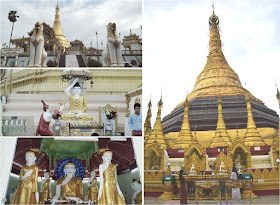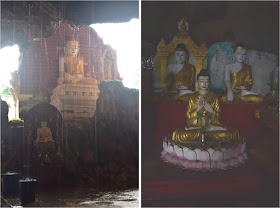Part 2 - Click here
Mawlamyine is the fourth biggest city in Myanmar and famous for its nearby sights and attractions, especially the largest reclining Buddha in Myanmar. The Mon name which was previously used for Mawlamyine, Moulmein means "damaged eye" or "one-eyed man." According to legend, a Mon king had a powerful third eye in the centre of his forehead, able to see what was happening in neighbouring kingdoms. The daughter of one of the neighbouring kings was given in marriage to the three-eyed king and managed to destroy the third eye.
Mawlamyine is the fourth biggest city in Myanmar and famous for its nearby sights and attractions, especially the largest reclining Buddha in Myanmar. The Mon name which was previously used for Mawlamyine, Moulmein means "damaged eye" or "one-eyed man." According to legend, a Mon king had a powerful third eye in the centre of his forehead, able to see what was happening in neighbouring kingdoms. The daughter of one of the neighbouring kings was given in marriage to the three-eyed king and managed to destroy the third eye.
Mawlamyine is a unique combination of landscape, beauty and
melancholy. The setting inspired both George Orwell and Rudyard Kipling, two of
the English-language writers most associated with Myanmar. Kipling penned his
famous poem 'Mandalay' after visiting, while Orwell, whose maternal grandmother
was born here, used Mawlamyine as the backdrop for the essays 'Shooting an Elephant'
and 'A Hanging'.
Win Sein Taw Ya
Win Sein Taw Ya is a 560ft-long reclining Buddha, which is
one of the largest such images in the world. It is a massive construction with
500 roadside monk statues. We could go inside this huge statue and visit
different rooms that showcase dioramas of the teachings of Buddha and a shrine.
It is surrounded by a forest of other pagodas and shrines.
Khat Ya Khat Yu Pagoda, Sitting Big Buddha
Then there was this huge sitting Buddha, which has a pagoda
and museum inside.
Kyaikkami Yele Pagoda
Kyaikkami is a city in Mon State, Myanmar. Kyaikkami Yele
Pagoda or Kyaik-kami Ye Le Paya was constructed on the sea using the natural
foundation of its ocean reefs, which is connected with the corridor to the
beach. It is said that even during the rainy season the sea water never passes
base of the Pagoda area. Women are only allowed to worship from a pavilion away
from the shrine while men can do so from the hall facing the main image.
We had nice lunch from a shack on the sea shore, then bought
some local sweets and enjoyed the candied orange, orange peels cut into small pieces and grated, sweetened with palm syrup.
Uzina pagoda and Kyeik Than Lan Pagoda
This is another attractively laid out temple surrounding a
giant gold-leaf clad stupa. The stupa has connecting west, south and north
shrines (east is the main entrance). According to legend the temple was
constructed by a monk named Uzina who dreamt of a buried treasure located at
this spot. After digging around a bit he came across a fabulous stash of gems.
From the proceeds he financed the construction of the temple. When we came down
after visiting the shrine, we saw an Indian selling awesome pakodas. How could
we leave without enjoying those hot pakodas?
The Kyeik Than Lan pagoda was erected in 875 A.D. during the
reign of King Mutpi Raja. A hair relic of the Buddha, Tripitaka manuscripts and
gold images of the Buddha were enshrined in the pagoda. There are 34 small
pagodas called Zediyan surrounding the pagoda. Kyeik Than Lan was the pagoda
that the famous English poet Rudyard kipling wrote about in his poem “Mandalay”
which opens with the line: By the old Moulmein Pagoda, looking lazy at the
sea”.
Kyaik Htee Saung Pagoda
Kyaik Htee Saung Pagoda is located on a laterite stone
hillock near the town of Bilin. The hillock itself is formed by the layering of
laterite stones on top of one another, forming a large square that gradually
tapers upward. In the 236 Buddhist Era, King Culasirimasoka of Thuwunna Bonmi enshrined
a tooth relic of the Buddha in the pagoda.
Over time, the pagoda became
derelict due to a lack of care. The umbrella of the pagoda started tilting.
Because of this, the pagoda was called Kyaik Htee saung, which means "The
Pagoda with Tilting Umbrella" in the Mon language.
Here the body of a monk was kept in a casket. When I looked
at the photograph of the monk, I noticed his deep penetrating eyes and the
whole place felt very powerful.
There was another monk visiting here and there
were lot of people waiting peacefully for his darshan.
After that we had a long drive to Yangon, checked into a
nice hotel ‘Lotus bed and breakfast’. A nice local couple (husband originally
from India and wife from Nepal) took us to an Indian restaurant for dinner.
Next day morning I had a nice interaction with local dentists after giving an
Endodontic presentation.
Then we met a Reiki channel, an interesting lady, at
the ‘Nourish Cafe’, a vegan restaurant.
We started the drive from Yangon to Inlay lake, since it was
a long drive, halted for the night in Taungoo at the ‘Mother’s house hotel’. It
was a huge property with a nice garden and carvings.
Next day after a long drive we reached Inlay Lake in Shan
state, checked into Hotel Remember Inn. Then we went out to watch a beautiful
sunset and fixed boat ride for the next morning.
At 8 am we reached the pier and I gasped on seeing the puny
boat on which we will be riding almost the whole day. But they were very
professional and can you imagine, in spite of getting down at many places and
getting back into the boat, our clothes never got wet. They gave us umbrellas
to keep off the harsh Sun. We saw the floating village and floating tomato
cultivation, and a fisherman balancing on one leg on the corner of his small boat
and fishing.
The Phaung Daw Oo pagoda
The Phaung Daw Oo pagoda is the most highly revered monastery
in the Inle Lake area, housing five ancient images of the Buddha that are
completely covered in golf leaf. It is reached by boat from Inlay Lake to the
landing pier.
We had lunch in a floating restaurant and proceeded to Shwe
Inn Thein pagoda. After getting out from the boat and walking for a short
distance, we noticed that it was a long walk and the weather was too hot. Right
then motor bike taxi persons came and took us to the pagoda.
The Shwe Indein Pagoda
Shwe Inn Thein Paya is a complex of 1054 weather-beaten zedi
(stupas), constructed in the 17th and 18th centuries. Some of the zedi lean at
crazy angles while others have been reconstructed. The stupas range from golden
to brick to white washed to crumbled.
Long necked women
Our last stop was to visit women of the Kayan tribes. Women
of the Kayan Lahwi tribe are well known for wearing neck rings, brass coils
that are placed around the neck, appearing to lengthen it. The women wearing
these coils are known as "giraffe women" to tourists. Girls first
start to wear rings when they are around 5 years old. Over the years, the coil
is replaced by a longer one and more turns are added. The weight of the brass
pushes the collar bone down and compresses the rib cage.
The coil, once on, is seldom removed, as the coiling and
uncoiling is a lengthy procedure. It is usually only removed to be replaced by
a new or longer coil. Some say the rings would offer protection from tiger
attacks often aiming right for the neck, others speculate it would keep rival
tribes from abducting the women by lessening their beauty. Most likely it would
be the opposite, the sheer beauty and pride in putting emphasis on the womens’
necks, giving the Kayan a divine grace.
The great dinner
After the wonderful boat ride we went back to the room, took
some rest, went to ‘The Ancestor restaurant’ and had the best dinner we had in
Mayanmar. The owner was a very friendly person and we had a long chat. He told the restaurant was started by his grandparents and now it is the third generation running it. So it was given the current name. The dessert, fried banana in coconut milk (not there in the picture) was
just soo divine!
Part 4 - Click here
References:

















































